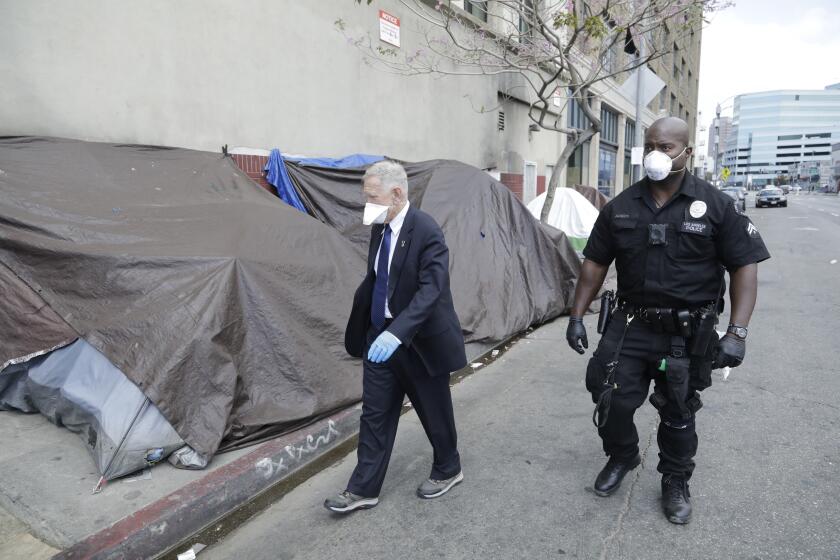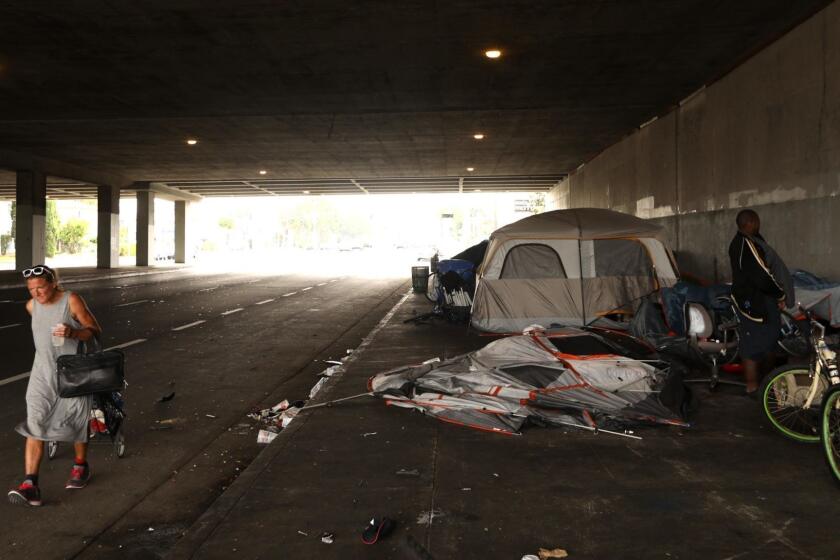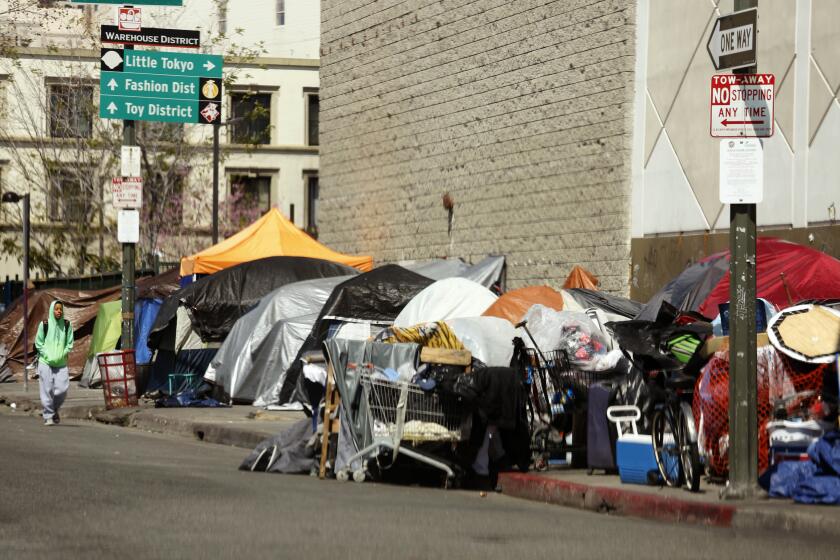Skid row is skeptical of judge’s order to sweep homeless people into shelters
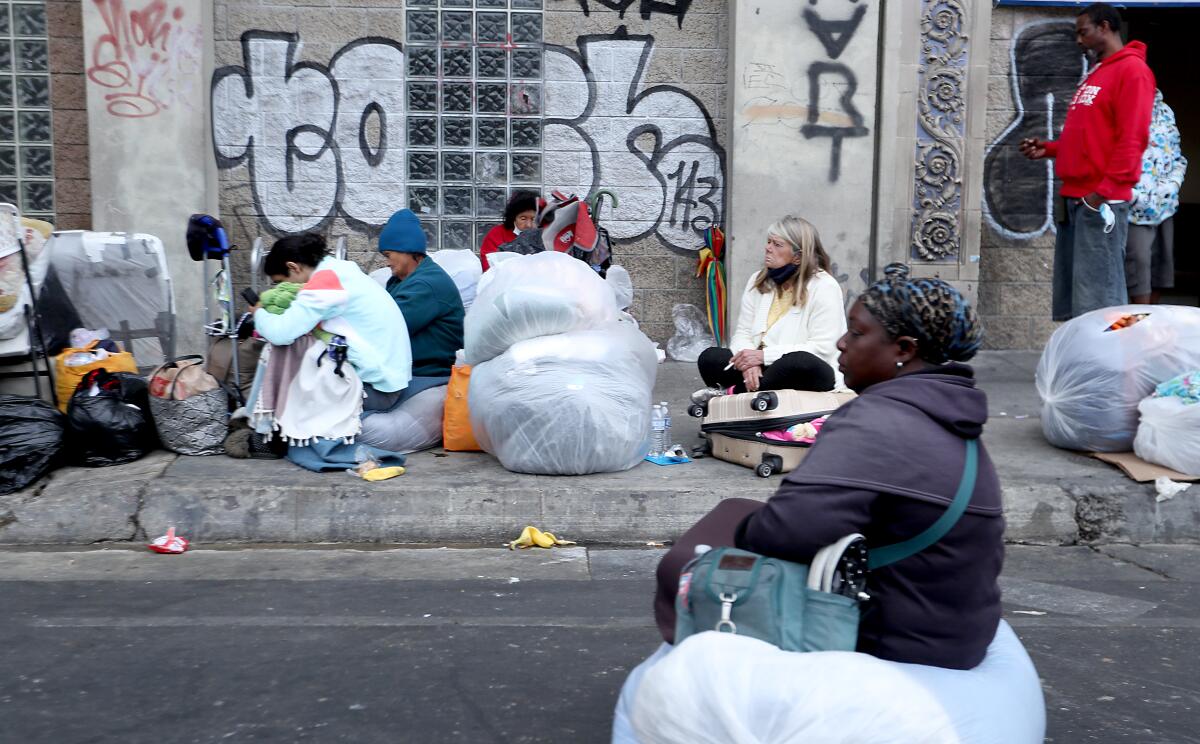
- Share via
U.S. District Judge David O. Carter’s order to Los Angeles officials to sweep homeless people off skid row into shelters or housing is grounded in his conviction that a wrongheaded focus on creating permanent housing has perpetuated racism, spread encampments and caused the avoidable deaths of Black people.
But the complexities of the lives of homeless people on skid row suggest that shelters may be, at best, an incomplete and unwelcome solution to the homelessness that has persisted in the 50-block district downtown for more than 50 years.
“They’re putting the smallest Band-Aid on a hemorrhaging wound,” said skid row activist and poet Suzette Shaw. “They don’t think we are real people.”
Carter’s injunction, which came in response to a lawsuit by downtown business and development interests, strikes at the heart of a debate that has roiled homelessness policy for decades: whether shelters and enforcement against street camps or permanent housing with counseling and other services can best end the long-running homelessness crisis.
The injunction pertains only to skid row and a buffer zone around it, where an estimated 2,000 people live in sidewalk tents and shantytowns. Carter wants every one of them offered shelter by Oct. 18 and pledges to uphold the constitutionality of anti-camping enforcement laws the city could use to remove homeless people if authorities choose. He also told Mayor Eric Garcetti to put $1 billion in escrow to fund the plan.
Lawyers for Los Angeles County, which was named in the case along with the city of L.A., said late Wednesday that they would appeal Carter’s order to the 9th U.S. Circuit Court of Appeals.
A federal judge has ordered the city and county of Los Angeles to offer some form of shelter to skid row’s entire homeless population by October.
Skid row in its early days was an enclave of small hotels, movie theaters and cheap eateries that served transient workers in seasonal industries and nearby railroads. In the 1950s, it evolved into a place where alcoholics and other people down on their luck could get a meal and a bed. While other cities opened public shelters, L.A. relied largely on religious and other institutional missions.
In the 1970s, as veterans of the Vietnam War returned with addictions, followed by the crack epidemic, officials adopted a containment policy, concentrating missions, shelters and other homeless services on skid row and using roadblocks and police enforcement to confine homeless people to the area.
As the affordable housing shortage worsened following the Great Recession, encampments spread throughout metropolitan L.A., without visible improvement to the shantytowns and tent cities spread over block after block on skid row.
Garcetti and a Democratic majority on the Los Angeles County Board of Supervisors adopted a $1.2-billion construction plan emphasizing permanent supportive housing — which includes long-term leases and counseling and other services. But the effort has been stalled by delays and cost overruns.
Several downtown activists applauded Carter for stepping in where they believe local officials have failed.
Homelessness policy in Los Angeles has been marked by fits and starts over the years — often centered on skid row and downtown, although Hollywood, Venice and the San Fernando Valley have long had their own problems.
“It’s about time he stood up, and there should have been other judges to stand up and start right where the fire is, right here in skid row,” said Wendell Blassingame, a member of the Downtown L.A. Neighborhood Council.
But Pete White of the Los Angeles Community Action Network said the last time authorities promised to clear skid row was in 2005, under Mayor Antonio Villaraigosa and Police Chief William J. Bratton’s Safer Cities Initiative, which set out to couple enforcement of low-level offenses on skid row with increased resources and encouragement to enter shelters.
The promised resources vaporized, and “we know how that turned out,” said White, the longtime director of the Los Angeles Community Action Network, a skid row anti-poverty group. “Three years later, 27,000 arrests, 6,000 citations and uncounted people disqualified and pushed out of the housing they had” because of their records, he said.
“He’s lacing Abraham Lincoln quotes in, but basically saying they could provide pallet shelters, tool sheds, anything will do,” White said of Carter’s order. “It’s out of sight, out of mind again, all temporary.”
“They think all we need is a squat and an indoors tent,” said Shaw.
Blassingame agreed shelters must be a path to a more permanent solution, but he also thinks money has been wasted on building up the homeless services industry.
There is something to be said for shaking a fist and demanding better. But I also know from personal experience that you can’t impose magical deadlines for getting people off the street,
“They’re spending too much on high salaries for employees and the vehicles they drive instead of spending it on the homeless people themselves,” Blassingame said. “I could show you so many warehouses in the 40-block area around skid row that are vacant and could easily be converted for housing.”
Other critics said Carter is not accounting for the complexity of the drug and mental health problems that affect an estimated 30% to 50% of the unhoused people on skid row.
Randall Pierce, 50, was in a park late Tuesday waiting out a quarantine before reentering the Los Angeles Mission and thought it would be “great to give more people a place to lay their heads.”
Pierce, a musician with decades of mental health and substance abuse issues behind him, has been in and out of shelters for years. He recently completed two drug treatment programs and plans to enter a third after relapsing.
“If people don’t get sobriety the first time, the system expels them,” said Mark Casanova, head of Homeless Health Care Los Angeles, which serves active drug users.
“The way shelters operate is to expel people that are trouble,” he said. “We would have to fix the shelter system, because it’s not working.”
“Housing is a better way to go,” Pierce said.
Shelter offers, backed by enforcement, could embroil L.A. in another confrontation that would dwarf the disturbances over the city’s recent police action to remove a sprawling tent city from Echo Park Lake, several advocates said.
Other observers noted that clearing the tents may not end the disorder in the streets that business interests and downtown loft residents object to. Many skid row residents live in cramped rooms in converted flophouses and other buildings, are un- or underemployed, and mark time outside on street corners and parks. They are still very poor, and they and other residents and visitors resort to their old hustles.
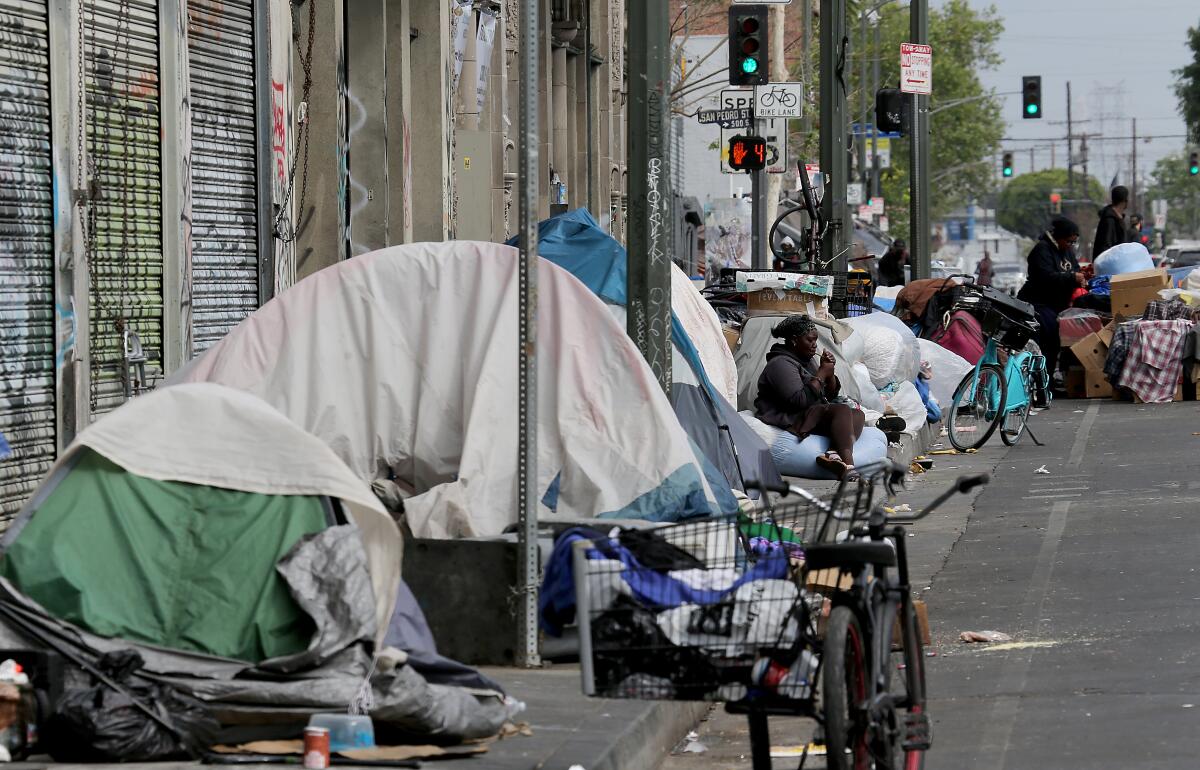
On Tuesday, Joy Colbert sat at a card table on 5th Street next to a woman grinding marijuana buds in a small hand grinder. Colbert handed a polystyrene foam cup of tea to a passerby and added a bill to a wad in her hand.
“I’m a product of being homeless and not having a place to stay, and I got housing” on skid row, Colbert said.
People get lonely and leave their housing, two case managers said. They sleep in tents inside their rooms or continue to scrounge through dumpsters and hoard belongings.
“They are reverting back to ways they know how to survive,” said Charles Augustus, 31, a case manager for Skid Row Housing Trust. “Housing is looked at as something they did without for years. But this is their neighborhood.”
Several homeless people supported Carter’s ideas to snip out red tape and build cheaper and faster housing, including motel conversions and prefabricated and modular units. “A tiny house is fine,” said Shanicka Bryan, 40.
But they reject the city’s dorm-style Bridge Home shelters and tiny-house villages with bunkhouse bathrooms.
“We need our own little houses; everybody has to have their own separate bathrooms,” Bryan said. “She might be really, really clean, and I’m not…. Ain’t anybody going to stay in shelter their whole life. We need a certain amount of distance.”
Bryan’s companion, Ashlee Gatewood, 29, said drugs and a lack of housing are just part of what landed her and her friends on skid row.
“There is trauma, there is discrimination,” said Gatewood, adding that a long stint in juvenile detention continues to limit her options. “We are not treated as equals.”
The threat of arrest doesn’t faze Bryan or Gatewood.
“I’m going to say, ‘Take me to jail. How long do I have to be there?’” Bryan said. “I won’t go to shelter.”
Times staff writers Doug Smith and Benjamin Oreskes contributed to this report.
More to Read
Sign up for Essential California
The most important California stories and recommendations in your inbox every morning.
You may occasionally receive promotional content from the Los Angeles Times.
